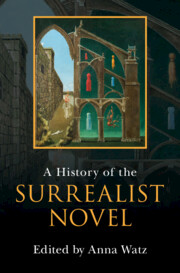Book contents
- A History of the Surrealist Novel
- A History of the Surrealist Novel
- Copyright page
- Dedication
- Contents
- Figures
- Contributors
- Acknowledgements
- Introduction
- I Marvellous Beginnings
- Chapter 1 Autobiography
- Chapter 2 Diverging Genealogies of the Surrealist Unconscious
- Chapter 3 Automatism, Autobiography, and Thanatography in the Surrealist Novel
- Chapter 4 Urban Nature: The City in the Surrealist Novel
- Chapter 5 Nostalgia and Childhood in the Surrealist Novel
- Chapter 6 Surrealist Collage Narrative
- II Transgression and Excess
- III Science, Alchemy, Nature
- IV Transnational Surrealism
- Index
Chapter 5 - Nostalgia and Childhood in the Surrealist Novel
from I - Marvellous Beginnings
Published online by Cambridge University Press: 02 February 2023
- A History of the Surrealist Novel
- A History of the Surrealist Novel
- Copyright page
- Dedication
- Contents
- Figures
- Contributors
- Acknowledgements
- Introduction
- I Marvellous Beginnings
- Chapter 1 Autobiography
- Chapter 2 Diverging Genealogies of the Surrealist Unconscious
- Chapter 3 Automatism, Autobiography, and Thanatography in the Surrealist Novel
- Chapter 4 Urban Nature: The City in the Surrealist Novel
- Chapter 5 Nostalgia and Childhood in the Surrealist Novel
- Chapter 6 Surrealist Collage Narrative
- II Transgression and Excess
- III Science, Alchemy, Nature
- IV Transnational Surrealism
- Index
Summary
This essay explores attitudes towards childhood in the surrealist novel but does so not via the familiar lens of psychoanalysis but via the concept of ’nostalgia’ as theorized by Svetlana Boym in her book The Future of Nostalgia (2001). Taking two contrasting examples of surrealist writing on childhood – Giorgio de Chirico’s seminal Hebdomeros (1929) on the one hand and Michel Leiris’s autobiographical novels Manhood (1939) and Scratches (1948) on the other – it is argued that, in both cases, Boym’s concept of ’reflective nostalgia’ (as opposed to ’restorative nostalgia’) provides a useful tool of analysis. However, the melancholic tone of de Chirico’s writing – with its stylistic debts to Lautréamont and Nietzsche – has a regressive dimension, and lacks the self-reflexivity specified in Boym’s account of a critically incisive ’reflective’ nostalgia. By contrast, Leiris’s more robust exploration of his male sexuality, along with the ’anthropological’ tenor of his analysis of the linguistic and material universe of childhood, fits more productively with Boym’s conception of a positive role for nostalgia within modernism.
- Type
- Chapter
- Information
- A History of the Surrealist Novel , pp. 87 - 101Publisher: Cambridge University PressPrint publication year: 2023

